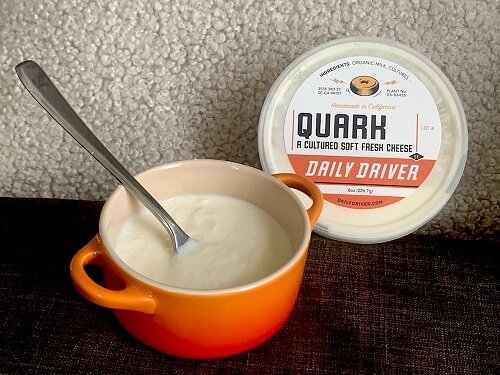Getting to Know Quark
Quark from Daily Driver
If you head to the cheese section of a good grocery store and look carefully among the tubs of cream cheese, farmers cheese, and crème fraiche (or even near the yogurts), you might find something less common: a tub of a European fresh cheese called quark. The cheese will be creamy and slightly sour, like a fermented yogurt, but thick, with a texture somewhere between Greek yogurt and cottage cheese or fresh ricotta.
Making quark
“Quark” is simply the German word for curd, and this cheese couldn’t be easier to make. “It’s just milk and cultures,” says Hadley Kreitz, the cheesemaker at Daily Driver, the only “urban creamery” in San Francisco. “I just let the cultures sit overnight and it does the acidification for me, and I come in the next day and I put it into curd bags to drain, again, overnight, until it’s the consistency that I’m looking for.”
But just because quark is easy to make doesn’t mean it’s straightforward. In fact, cheeses labeled “quark” can have a wide range of textures. “If you Google quark, it comes up with a million different variations, anything from almost a crumbly feta-looking style to a super creamy, yogurty style,” says Kreitz. In Austria, quark (or “topfen” as it’s called in both Austria and southern Germany) is a bit thicker, like cream cheese, while in Germany it is thinner and more yogurt-like. In Switzerland, it is often sold like yogurt, and you can get it plain or flavored with vanilla or fruit.
Quark Danish by René Felbermayr
In the US, the texture of quark varies depending on the cheesemaker. Kreitz makes a style similar to German quark. It has a creamy consistency, a bit denser than cream cheese, and a texture that she compares to cottage cheese. “It’s universally useful. We use it in savory and sweet,” says René Felbermayr a pastry chef from Austria who does pop-ups at Daily Driver. “In Austria, we use it for open face sandwiches, where we add to the quark some salt, pepper, and a little bit of chives and spread that on a slice of bread. That’s very common.” For his pop-ups, Felbermayr uses Daily Driver’s quark in strudel (“topfenstrudel” in Austrian German) and as a filling for Danishes.
The staff at Daily Driver has also served quark paired with a seasonal fruit or fennel jam, and they sometimes use it as the base for a Turkish-style breakfast dish, topping it with a poached egg and chile oil. Kreitz says they’ve also been contacted by a local Russian restaurant because quark makes a good stand-in for tvorog, a popular Eastern European farmer’s cheese (though quark is generally not as firm as its Russian cousin).
Quark also sings all on its own, eaten like Greek yogurt, topped with honey or fruit. “I love how the milk changes throughout the seasons, how you can taste the grassiness during the spring,” says Kreitz. “With quark, you can taste the change. You’re basically just tasting yummy milk.”



